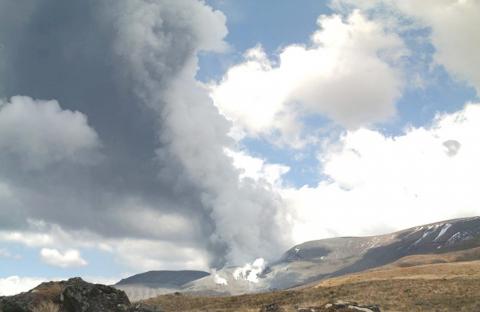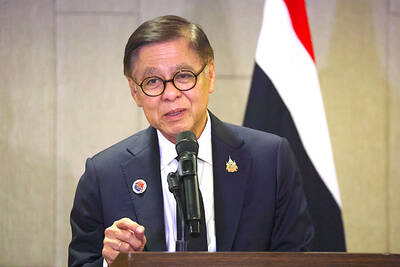A New Zealand volcano used as a backdrop to The Lord of the Rings films erupted yesterday, spewing a column of ash 3km above North Island, scientists said.
Vulcanologists said Mount Tongariro rumbled to life at 1:25pm in a five-minute burst that briefly closed roads, put aviation authorities on high alert and sent nearby hikers scrambling for safety.
“It was completely unexpected, there were no warning signs beforehand,” a spokeswoman for official monitoring service GNS Science said. “We were watching [neighboring volcano] Ruapehu waiting for an eruption and instead this came out of nowhere.”

Photo: AFP / GNS Science-Geonet
The mountain in the center of the North Island had been dormant for more than a century until August this year, when a massive blast ripped a new vent in its side and hurled boulders the size of cars more than 2km.
While officials said the latest eruption was minor by comparison, they still closed a number of roads for a time and warned aircraft to stay away from the area as a precaution.
About 50 people, including schoolchildren, were hiking in the Tongariro National Park when the eruption occurred, but police said they were not in danger and there were no injuries.
Park guide Stuart Barclay said there was a sense of “not quite panic, but getting there” among students as they heard a loud bang and saw a billowing ash cloud rise before them.
“We got them out of there quick-smart,” he told national radio.
The national park, which was used to depict the desolate wasteland of Mordor in Peter Jackson’s hugely successful The Lord of the Rings movies, attracts 800,000 visitors a year to its ski-slopes and hiking trails.
Its three volcanoes do not directly threaten population centers, with the nearest town Taupo about 80km away, but they have proved deadly in the past.
An eruption at Mount Ruapehu in 1953 caused New Zealand’s worst rail disaster when it trigged a massive mudslide that washed away a bridge, causing a passenger train to plunge into the Whangaehu River with the loss of 151 lives.
Further north from the park, Mount Tarawera erupted in 1886 with a death toll estimated at 120 to 150.
New Zealand lies on the so-called “Pacific Ring of Fire,” where the Earth’s tectonic plates collide, making it a hot spot for volcanic and earthquake activity.
Local resident Clint Green said the latest eruption was “pretty spectacular.”
“All of a sudden a towering black plume just began erupting very quickly, skyrocketing up,” he told Radio New Zealand. “At first I didn’t believe what I was seeing.”
Airline services suffered only minor disruptions and all roads were open again by yesterday evening, but officials said the park around the volcano would remain closed for at least five days in case of further eruptions.
“Unlike August, there were no ballistics [flying rocks],” the GNS spokeswoman said. “This was basically just ash being expelled into the atmosphere, but we don’t know what could happen next.”
Locals were told they could expect light ashfall over the next few days, and were advised to stay indoors with windows and doors sealed.
Scientists warned about increased volcanic activity in the area this week, saying that neighboring Mount Ruapehu is in danger of erupting as pressure builds in a subterranean vent.
GNS said it was impossible to know if the rumblings at Mount Ruapehu and the surprise eruption at Mount Tongariro were linked.

REVENGE: Trump said he had the support of the Syrian government for the strikes, which took place in response to an Islamic State attack on US soldiers last week The US launched large-scale airstrikes on more than 70 targets across Syria, the Pentagon said on Friday, fulfilling US President Donald Trump’s vow to strike back after the killing of two US soldiers. “This is not the beginning of a war — it is a declaration of vengeance,” US Secretary of Defense Pete Hegseth wrote on social media. “Today, we hunted and we killed our enemies. Lots of them. And we will continue.” The US Central Command said that fighter jets, attack helicopters and artillery targeted ISIS infrastructure and weapon sites. “All terrorists who are evil enough to attack Americans are hereby warned

‘POLITICAL LOYALTY’: The move breaks with decades of precedent among US administrations, which have tended to leave career ambassadors in their posts US President Donald Trump’s administration has ordered dozens of US ambassadors to step down, people familiar with the matter said, a precedent-breaking recall that would leave embassies abroad without US Senate-confirmed leadership. The envoys, career diplomats who were almost all named to their jobs under former US president Joe Biden, were told over the phone in the past few days they needed to depart in the next few weeks, the people said. They would not be fired, but finding new roles would be a challenge given that many are far along in their careers and opportunities for senior diplomats can

Seven wild Asiatic elephants were killed and a calf was injured when a high-speed passenger train collided with a herd crossing the tracks in India’s northeastern state of Assam early yesterday, local authorities said. The train driver spotted the herd of about 100 elephants and used the emergency brakes, but the train still hit some of the animals, Indian Railways spokesman Kapinjal Kishore Sharma told reporters. Five train coaches and the engine derailed following the impact, but there were no human casualties, Sharma said. Veterinarians carried out autopsies on the dead elephants, which were to be buried later in the day. The accident site

RUSHED: The US pushed for the October deal to be ready for a ceremony with Trump, but sometimes it takes time to create an agreement that can hold, a Thai official said Defense officials from Thailand and Cambodia are to meet tomorrow to discuss the possibility of resuming a ceasefire between the two countries, Thailand’s top diplomat said yesterday, as border fighting entered a third week. A ceasefire agreement in October was rushed to ensure it could be witnessed by US President Donald Trump and lacked sufficient details to ensure the deal to end the armed conflict would hold, Thai Minister of Foreign Affairs Sihasak Phuangketkeow said after an ASEAN foreign ministers’ meeting in Kuala Lumpur. The two countries agreed to hold talks using their General Border Committee, an established bilateral mechanism, with Thailand